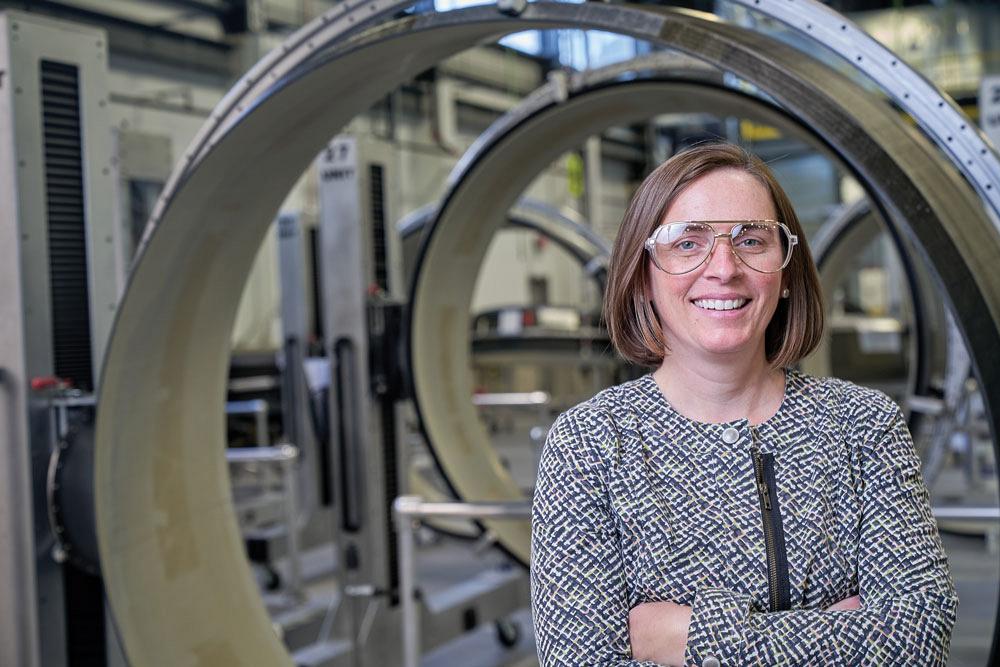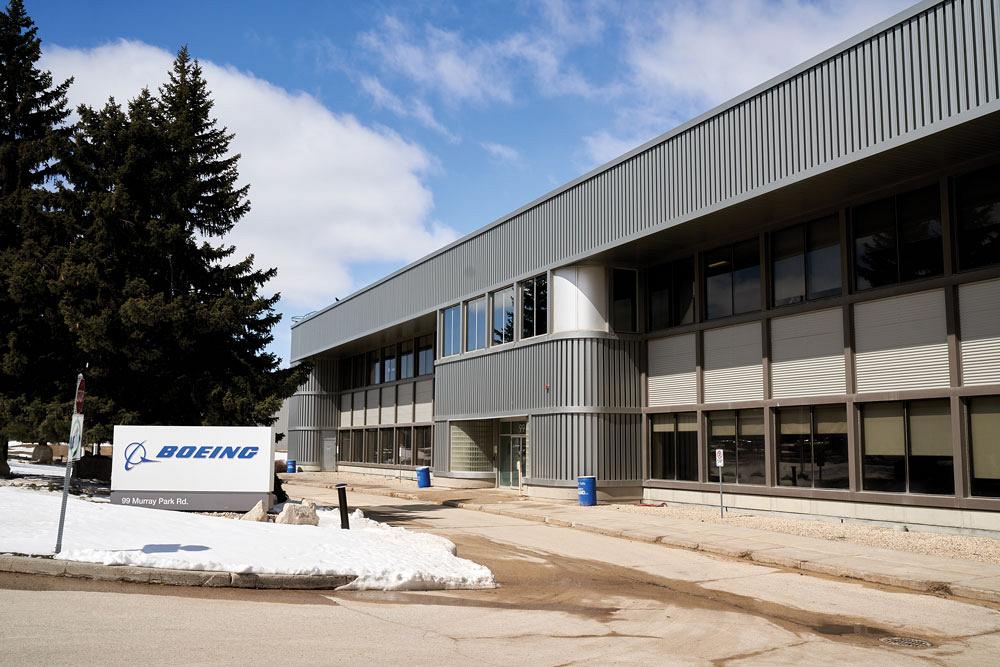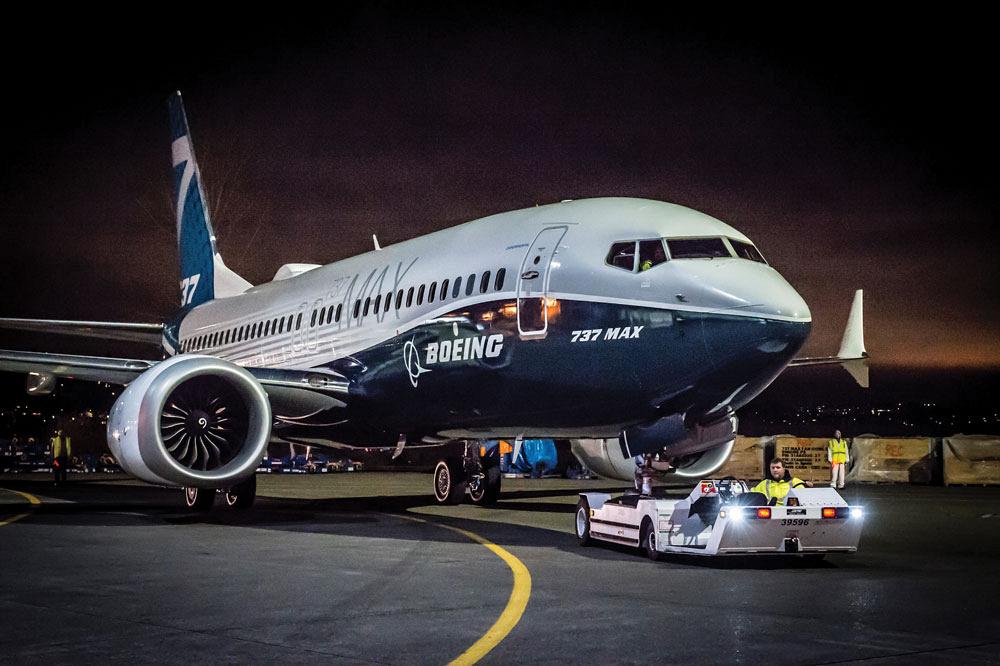Associate Editor
- FMA
- The Fabricator
- FABTECH
- Canadian Metalworking
The path to success
Boeing Canada Winnipeg’s Kathleen Garney gives insights into what she believes makes a good leader
- By Lindsay Luminoso
- August 22, 2022
- Article
- Made In Canada

Kathleen Garney’s career in aviation spans the last 15 years. She joined BCW in September 2020 and was named general manager in November 2021. Ian McCausland Photography
As Kathleen Garney walked the floor of Boeing Canada Winnipeg (BCW), she was greeted with smiles and waves by employees. Donning all the proper safety gear, she interacted with workers on the line, asked them how they were doing, and showed off all the new and enhanced technology on the shop floor.
Garney joined BCW in September 2020 as operations director and was named general manager in November 2021. However, her career in aviation spans the last 15 years.
Her Story
Like many high school students, choosing a career path at the age of 17 or 18 can feel daunting. Not everyone knows what they want to do for a living.
"It feels like many of the important aspects of my life are things I just stumbled into," said Garney. "While applying to college I was required to declare a major, and I really had no idea what I wanted to do. My mom pointed out that I really liked math and science, which essentially is what an engineer does. I did a little research and applied to become a materials engineer. Getting informed about what was available to me made the decision much easier."
After graduating, Garney did some civil engineering but realized that while she enjoyed the work, it definitely was not something she wanted to do for the rest of her life.
"There has to be some level of enjoyment and fulfillment associated with work," she said.
While at a BBQ with a bunch of engineer friends, Garney stumbled into a conversation with a colleague who happened to be changing jobs and noted that there was an opening at a forging house.
"Because of that one offhanded conversation, my colleague put me in touch with the hiring manager. I got an interview and then the job," she said. "I thought, what a great place to work. It was that first job working as a metallurgist at the forging house that really gave me the manufacturing bug."
As an engineer, you’re always solving problems that are associated with processes, parts, and equipment. However, Garney did not see herself becoming a subject matter expert, but she did love the problem solving aspects of engineering. Another chance conversation with her mentor led her to realize that a management position would allow her to continue the problem solving she loved but with a focus on people.
"I got to take all of my knowledge and skills developed during my time as an engineer and apply them to management within operations," said Garney. "I still get to satisfy my curiosity with how to physically transform a part to make a product that someone wants to buy, but then also get to deal with problem solving with people and managing people. I made that transition from engineering into operations management and my love of manufacturing was supercharged by that."

Garney is excited that there seems to be a renewed energy in establishing local manufacturing capability in Canada, which is really great for Boeing. Ian McCausland Photography
An Effective Leader
While Garney noted that many moments of her career came about by happenstance, it is her work ethic and drive that have led to her success.
She moved from forging to casting to eventually landing at Boeing in Seattle where she moved up the ranks from manufacturing manager to director at the company’s Tube, Duct and Reservoir Center.
Garney’s openness and transparency about her ambition allowed for her to take on increasing responsibilities that were both collaborative and results-driven.
"For me, it was all about delivering on results that showed the total value of the team rather than just scratching in line to get ahead," she said. "Sometimes engineers tend to come into a room and, because they have a degree and all this depth and breadth of knowledge, believe they have the answers to everything. You want to be careful that you don’t create this image that you think you are better than your team or know more than them. You have to be incredibly humble."
Garney learned this lesson early in her career during one of her first management positions. The team lead often would take her aside and explain to her how she was being perceived by the team and her peers, while also providing her with constructive feedback.
"Leaders and mentors come in all different positions, and a title doesn’t really mean anything," she said. "I had this learning moment—I can’t just assume that as a manager I know everything or just because some-one has a title that they have all the answers. The best source of information comes from the people on the floor, and it’s important to get a variety of voices and lift those voices up."
Garney is most proud of the goals she has been able to accomplish with her team. Whenever she’s set a goal, she has been able to attain it ahead of schedule.
"I’ve been able to do that because I accomplish nothing alone," she said. "I build teams very quickly and effectively, and those teams help me to accomplish the work. I can deliver results quickly, and that helps me achieve my personal career goals. I’m proud of the pace I’m on and I think it speaks to my ability to deliver results."
Coming into an existing team that has been operating with an established workflow can be a challenge. Not everyone loves change, and disruption can lead to resistance. However, one of Garney’s strengths as a leader is identifying areas of opportunity within teams, bringing in necessary skillsets, and establishing an operating rhythm and system that eventually becomes commonplace.
"Once team members see the results that can be achieved with a little optimization, it really helps set the tone," said Garney. "Oftentimes workers will come back and let me know that the new way is way better than existing practices. I see that here all the time with changes that have been implemented at BCW. Previously, the company and workers were prioritizing things that they thought were important, but in some cases it came at the expense of our ability to deliver on time to the customer. And ultimately our goal here is to ensure that we never impact our customers or the airplane programs. And so we have to ensure that we’re diligent to our schedules. That’s one of the big changes or successes we’ve been able to see here."

One of Garney’s strengths as a leader is identifying areas of opportunity within teams, bringing in necessary skillsets, and establishing an operating rhythm and system that eventually becomes commonplace. Boeing
Manufacturing in Winnipeg
The pandemic has proved that manufacturing in Canada is the foundation of the supply chain, and where manufacturing is located significantly affects that supply chain.
"What I’m most excited about in the future is that there does seem to be a renewed energy in establishing local manufacturing capability in North America," said Garney. "And lots of that manufacturing will be located in Canada, which is really quite amazing for us, Boeing, and the country. We make some of the coolest stuff."
Coming out of the pandemic and achieving stability is important for the aerospace giant to achieve its goals and move on to new and exciting projects. BCW is an integral part of the success of the company as a whole and provides a number of different components for various Boeing commercial aircraft.
"There is something really special about making something, about creating a product that people can see and use," said Garney. "For example, at the forging house, I actually made a rotating seal for the CFM56 aircraft engine. It makes what I was doing tangible, like I was really doing something, which gets lost in other industries."
And now that travel and the aerospace industry is picking back up again, BCW is excited to welcome back many of the employees it was forced to layoff during the pandemic. Having workers that are already trained and have the muscle memory will allow the company to transition back to full capacity more smoothly.
One thing that has helped BCW engage with its employees during the pandemic was its use of communication technology. Garney noted that Boeing was not an early adopter of engagement technology, but the pandemic made it necessary. With WebEx and Zoom, the company is able to engage with a diverse group of people.
"The reality is that we need to expand and engage with different sectors of the population," said Garney. "We’ve come out of the pandemic and we’re trying to recall people, but there’s a labour shortage across everything. How do we go and compete for that skilled talent? What value do we need to provide to the employee or to the prospective employee in order to have them be part of our team?"
For Garney, an important aspect of her leadership was shifting the focus back to the employee, putting them front and centre. A career at Boeing has to be about more than just a paycheck, it has to be about the culture and experience of the workforce on a daily basis. There is a big shift in employment to set priorities beyond a job’s quantifiable aspects, which is why Garney feels grateful to her predecessors for implementing a number of initiatives at BCW, including a shift away from repetitive, body-centric tasks; an industrial athlete program; a safety champion program; and others that BCW employees can turn to for career enhancement.
"A favourable business environment also is essential for success," said Garney. "I think that’s why so many companies are successful in Winnipeg. There is really this synergy between various sectors of the greater aerospace industry. For example, we buy sub-components, like seals, from Argus Industries, which is across the street. That’s something new for us. We definitely are seeing more local collaboration."
Garney credits local colleges and universities, specifically Red River College, for fostering that collaboration and developing a pipeline for all different functions and skills needed for the industry to thrive. It’s that pipeline, Garney believes, that provides people with a viable path and well-paying jobs, and it keeps people in Winnipeg.

BCW is an integral part of the success of the company as a whole and provides a number of different components for various Boeing commercial aircraft including the 737 MAX family. Boeing
"In my time in Winnipeg, there is a definite feeling that people from here love it and want to stay here," said Garney. "There’s a great value proposition for younger people to remain in Winnipeg and Manitoba, which I think helps. Within manufacturing there is a broad spectrum of what you can do. There’s many different roles that you can explore. I think the real differentiator of this industry is that there are so many options available for young people to try and see what works for them over some of the narrower tracks people move into."
For more about Boeing Canada Winnipeg’s aerospace manufacturing operations, check out "Success at Boeing Canada Winnipeg" from the September 2022 issue of Canadian Fabricating & Welding.
Associate Editor Lindsay Luminoso can be reached at lluminoso@canadianmetalworking.com.
Boeing Canada Winnipeg, www.boeing.ca
About the Author

Lindsay Luminoso
1154 Warden Avenue
Toronto, M1R 0A1 Canada
Lindsay Luminoso, associate editor, contributes to both Canadian Metalworking and Canadian Fabricating & Welding. She worked as an associate editor/web editor, at Canadian Metalworking from 2014-2016 and was most recently an associate editor at Design Engineering.
Luminoso has a bachelor of arts from Carleton University, a bachelor of education from Ottawa University, and a graduate certificate in book, magazine, and digital publishing from Centennial College.
subscribe now


Keep up to date with the latest news, events, and technology for all things metal from our pair of monthly magazines written specifically for Canadian manufacturers!
Start Your Free Subscription- Industry Events
MME Winnipeg
- April 30, 2024
- Winnipeg, ON Canada
CTMA Economic Uncertainty: Helping You Navigate Windsor Seminar
- April 30, 2024
- Windsor, ON Canada
CTMA Economic Uncertainty: Helping You Navigate Kitchener Seminar
- May 2, 2024
- Kitchener, ON Canada
Automate 2024
- May 6 - 9, 2024
- Chicago, IL
ANCA Open House
- May 7 - 8, 2024
- Wixom, MI




















